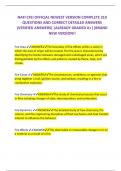NAFI CFEI OFFICIAL NEWEST VERSION COMPLETE 310
QUESTIONS AND CORRECT DETAILED ANSWERS
(VERIFIED ANSWERS) |ALREADY GRADED A+||BRAND
NEW VERSION!!
Fire Area ✔✔ANSWER✔✔The boundary of fire effects within a scene in
which the area of origin will be located. The fire area is characterized by
identifying the border between damaged and undamaged areas, which are
distinguishable by fire effects and patterns created by flame, heat, and
smoke.
Fire Cause ✔✔ANSWER✔✔The circumstances, conditions, or agencies that
bring together a fuel, ignition source, and oxidizer, resulting in a fire or
combustion explosion.
Fire Chemistry ✔✔ANSWER✔✔The study of chemical processes that occur
in fires including changes of state, decomposition, and combustion.
Fire Dynamics ✔✔ANSWER✔✔The detailed study of how chemistry, fire
science, and the engineering disciplines of fluid mechanics and heat transfer
interact to influence fire behavior.
Fire Effects ✔✔ANSWER✔✔The observable or measurable changes in or on
a material as a result of a fire.
,Fire Hazard ✔✔ANSWER✔✔Any situation, process, material, or condition
that can cause a fire or explosion or that can provide a ready fuel supply to
augment the spread or intensity of a fire or explosion, all of which pose a
threat to life or property.
Fire Investigation ✔✔ANSWER✔✔The process of determine the origin,
cause, and development of a fire or explosion.
Fire Investigator ✔✔ANSWER✔✔An individual who has demonstrated the
skills and knowledge necessary to conduct, coordinate, and complete a fire
investigation.
Fire Patterns ✔✔ANSWER✔✔The visible or measurable physical changes, or
identifiable shapes, formed by a fire effect or group or fire effects.
Fire Scene Reconstruction ✔✔ANSWER✔✔The process of recreating the
physical scene during fire scene analysis investigation or through the
removal of debris and the placement of contents or structural elements in
their pre-fire positions.
Fire Science ✔✔ANSWER✔✔The body of knowledge concerning the study of
fire and related subjects ( such as combustion, flame, products of
combustion, heat release, heat transfer, fire and explosion chemistry, fire
and explosion dynamics, thermodynamics, kinetics, fluid mechanics, fire
safety) and their interaction with people , structures, and the environment.
,Fire Spread ✔✔ANSWER✔✔The movement of fire from one place to
another.
First Fuel Ignited ✔✔ANSWER✔✔Fuel that which first sustains combustion
beyond the ignition source.
Flame ✔✔ANSWER✔✔A body or stream of gaseous material involved in the
combustion process and emitting radiant energy at specific wavelength
bands determined by the combustion chemistry of the fuel. In most cases,
some portion of the emitted radiant energy is visible to the human eye.
Flame Front ✔✔ANSWER✔✔The flaming leading edge of a propagation
combustion reaction zone.
Flameover ✔✔ANSWER✔✔The condition where unburned fuel (pyrolysate)
from the originating fire has accumulated in the upper layer to a sufficient
concentration that ignites and burns. This can occur without ignition of, or
prior to the ignition of, other fuels separate from the origin.
Flammable ✔✔ANSWER✔✔Capable of burning with a flame.
Flammable Limit ✔✔ANSWER✔✔The upper or lower concentration limit at
a specified temperature and pressure of a flammable gas or vapor of an
ignitable liquid and air, expressed as a percentage of fuel by volume that an
be ignited.
, Flammable Liquid ✔✔ANSWER✔✔A liquid that has closed-cup flash point
that is below 100 degrees F and a maximum vapor pressure.
Flammable Range ✔✔ANSWER✔✔The range of concentrations between the
lower and upper flammable limits.
Flash Fire ✔✔ANSWER✔✔A fire that spreads by means of a flame front
rapidly through a diffuse fuel, such as dust, gas, or the vapors of an ignitible
liquid, without the production of damaging pressure.
Flash Point of a Liquid ✔✔ANSWER✔✔The lowest temperature of a liquid,
as determined by specific laboratory tests, at which the liquid gives off
vapors at a sufficient rate to support a momentary flame across its surface.
Flashover ✔✔ANSWER✔✔A transition phase in the development of a
compartment fire in which surfaces exposed to thermal radiation reach
ignition temperature more or less simultaneously and, given sufficient
availability of oxygen, fire spreads rapidly throughout the space, resulting in
full room involvement or total involvement of the compartment or enclosed
space.
Forensic ✔✔ANSWER✔✔The application of science to answer questions of
interest to the legal system.
Fuel ✔✔ANSWER✔✔A material that will maintain combustion under
specified environmental conditions.




